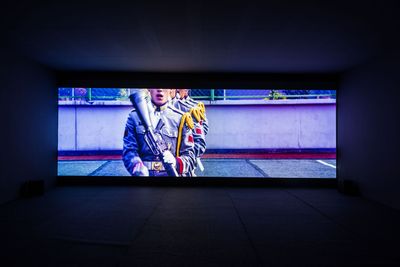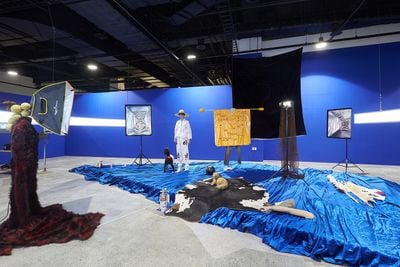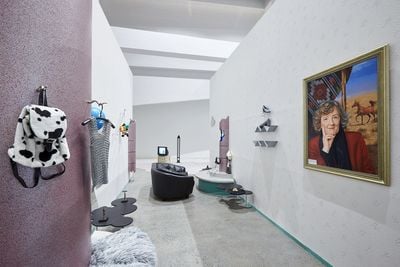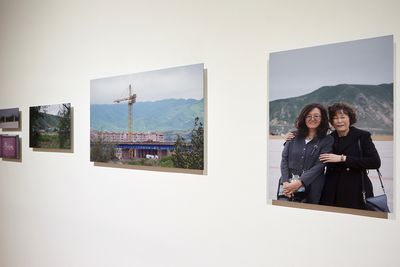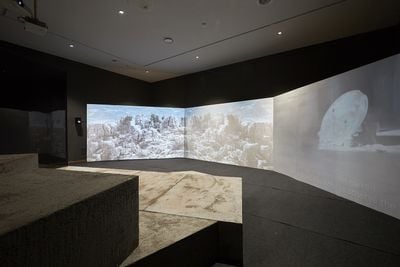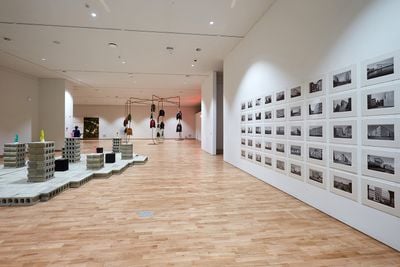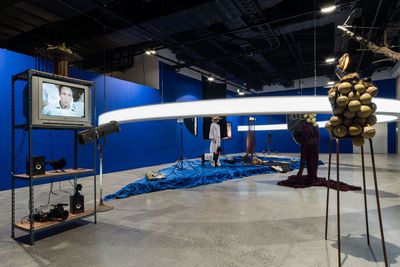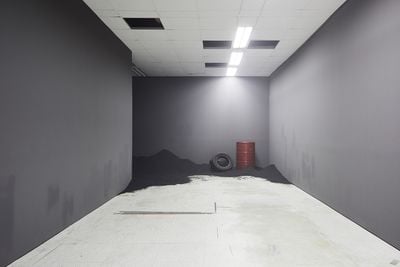Cristina Ricupero and Jörg Heiser
Cristina Ricupero and Jörg Heiser. Courtesy Cristina Ricupero and Jörg Heiser
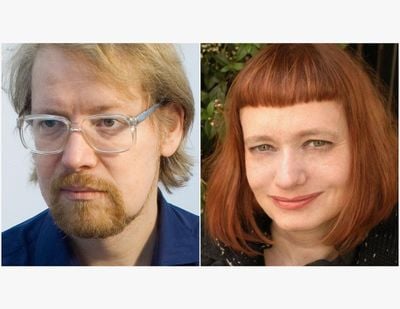
Cristina Ricupero and Jörg Heiser. Courtesy Cristina Ricupero and Jörg Heiser
Divided We Stand, the tongue-in-cheek title of the 9th Busan Biennale (8 September–1 November 2018), speaks to the psychological effects of borders on individual and collective social consciousness. Co-curated by artistic directors Cristina Ricupero and Jörg Heiser, with guest curator Gahee Park, the exhibition explores the divisions haunting history and contemporary news cycles; from the division of Germany and its reunification, North/South politics in Korea and the wider world, the ever-worsening situation in Israel and Palestine, not to mention Trump-era anti-immigration policies in North America and Europe.
Overall, the curators gesture toward geopolitical parallels, but are cautious of prescriptive solutions. Instead, they let layered tensions play out within the exhibition's two venues: the newly opened Museum of Contemporary Art Busan (MoCA Busan) and the iconic Bank of Korea, a heritage building that dates back to a time before the country was divided in 1953. The show employs an imaginative use of narrative that juxtaposes historical fiction with alternate futurist scenarios in order to visualise divergent politics that date back to the Cold War, while dealing with the heated theme of division.
Storytelling forms a core strategy throughout, and video and film are prominent among participating artists, who include Adrian Piper, the Propeller Group, Henrike Naumann, Kelvin Kyungkun Park, Hito Steyerl, Minouk Lim, and Lars von Trier. In the case of Kelvin Kyung Kun Park's single-channel, 17-minute video Army: 600,000 Portraits (2016), the artist explores the collective Korean psyche through the lives of soldiers conscripted into the Korean army. Mandatory military service has been in place since 1957—a few short years after the Korean War's stalemate—but the ongoing impact of division and the threat of war continues to affect the country's youth.
Ricupero has worked within the Korean art world for over a decade, serving as the curatorial adviser for the 2016 Seoul Mediacity Biennale at the Seoul Museum of Art, jurying for the 2012 Hermès Foundation Missulsang, and commissioning the European section of the 2006 Gwangju Biennale. She was the curator at the Nordic Institute for Contemporary Art from 2000 to 2005, the associate director of exhibitions at the ICA in London from 2000 to 2004, and co-curated New Ways of Doing Nothing (27 June–12 October 2014) at the Kunsthalle Wien in Vienna.
Ricupero first collaborated with Heiser, currently the co-publisher of frieze, for the 2016 Nuit Blanche Monaco. Heiser is a Berlin-based writer and editor, and a regular contributor to the Süddeutsche Zeitung, and is the director of the Institute for Art in Context in Berlin. He curated Romantic Conceptualism (14 September–1 December 2007) at the Kunsthalle Nürnberg and BAWAG Foundation Vienna.
You previously collaborated as curators for Nuit Blanche Monaco in 2016. This was the first time you worked together, right? What initiated your interest in applying jointly for the Busan Biennale?
Heiser: Yes, Nuit Blanche Monaco was our first collaboration, though we had known each other for almost 20 years by then. The collaboration in Monaco involved performances that took place all day and night, along with sculptural interventions. After that experience, we knew that we might want to work together again. In the autumn of 2017, Cristina came up from Paris to teach a seminar at the Berlin University for the Arts on how to curate a thematic group exhibition. It was with the students in Berlin that Cristina discussed and explored another exhibition idea that we are working on together for the future.
Ricupero: Another exhibition idea came up on that occasion. For some time, Jörg had been thinking about making an exhibition on the topic of divided or formerly divided countries such as Germany, Korea, or India/Pakistan. His wife's father was born in 1947 in India, amidst the wave of displacement that occurred as a result of the Partition of India. More than 14 million people were forced to leave their homes, resulting in refugee crises across the region and terrible outbreaks of violence. The point of the exhibition was to ask whether artists have probed these conflicts and histories, and whether it could be beneficial to bring works from these different parts of the world together.
Heiser: Cristina was rather sceptical. She pointed out that many exhibitions, especially biennales, had already dealt with borders and other connected issues. Of course, she was right. In fact, we agreed that although we were interested in some artworks that deal with borders, we were also weary of a certain piousness in evoking that theme. There exists a slightly tired rhetoric about the border that connects geopolitical factuality with philosophical tropes, and actual borders with allegorical boundaries.
In Berlin, we were having a few drinks and chatting when the topic of this exhibition came up again. Cristina had an important idea concerning the psychological dimension of territorial divisions. If we were to make such an exhibition, wasn't it the intricate connections between geopolitical questions and the mental feedbacks and traumas they induce that should be the focus? By coincidence, e-flux announced an open call for curatorial concepts for the Busan Biennale's 2018 edition. Given the relevance between our theme and Korea as a country that has been divided since 1945, with one of the most militarised and keenly guarded borders in the world, we knew we had to apply. So we did, and we were hired.
This year's title, Divided We Stand, speaks to the increasingly polarised nature of contemporary political discourse. What do you hope to uncover in shedding light on the materiality and intangibility of these dividing borders?
Heiser & Ricupero: Regarding the title Divided We Stand, it's always a little unrewarding to explain a joke or wordplay, but we'll do it anyway. It's an inversion of the common phrase, 'United we stand, divided we fall', which stems from ancient times. The Greek storyteller Aesop used it in his fable The Four Oxen and the Lion. Later, in the 18th century, it became a motto used during the founding years of the United States of America. In the 20th century, it was used during India's struggle for independence from the British, and by the Ulster loyalists in Northern Ireland, who have been, and are attached to, the British monarchy, and who are fiercely opposed to a reunion with the Republic of Ireland. Divided We Stand is a slightly tongue-in-cheek rejection of the use of the phrase as an appeal to patriotism, offering a factual statement instead of an appeal.
For us, charting and exploring the effect of geographies on the psycho-social level involves asking how political, economic, and military powers have created ways to inhabit and rule the world, and how their approaches either reinforce or erode these divisions. It also means asking what struggles result from this relationship between psyche and territory. Rather than emphasise borders, our focus is on the spaces that they define. Those spaces can be natural, socio-economic or ideological.
After the fall of the Berlin Wall and 9/11, it's as if the schizophrenic leanings of the Cold War era have been replaced with other, more complicated psychological conditions. As Hito Steyerl suggests, the Cold War hasn't ended, but keeps returning as if stuck in a loop, as military and secret service glory from that era is evoked from Moscow to Washington D.C. It is these psychological conditions that many of the artists in this exhibition explore, in probing and experimental ways that historians or scholars of political science wouldn't usually choose.
Both documentarian and fictional approaches are stressed in the language of this Biennale, with an emphasis on science fiction—a genre that looks at the human condition—that seems particularly timely. What advantage do you feel science fiction offers in finding fresh perspective on the discourse of social and political division?
Heiser & Ricupero: Science fiction is about the human condition. This might be why fiercely divided territories often feature in the plot of many science fiction novels. We would even go as far as saying that it is hard to find—among science fiction or fantasy stories that involve the imaginative depiction of future or parallel worlds—any narratives that do not involve an important plot point that revolves around fiercely divided territories generated by war or the threat of colonisation, or both.
In HG Wells' The Time Machine, for example, there is a division between the underground world of the Morlocks and the earthly world of the Eloi. This division is also present in The Lord of the Rings with its Elves and Orcs. Think, also, of the Black Gate of Mordor and what lies beyond it. Further examples might be Tarkovsky's Stalker from 1979, with its restricted Zone, or Philip K. Dick's Do Androids Dream of Electric Sheep from 1968, which was turned into the Blade Runner cinema saga. In Blade Runner 2049 (2017), mankind has left a post-apocalyptic world behind, where only androids remain. Another of our favourites is John Boorman's Zardoz (1974), with Sean Connery playing a 'barbaric' rebel. In Boorman's film, Connery has a ponytail and wears big, black leather boots and red trunks that look a bit like a diaper. In the film, he manages to enter a sealed-off zone where the elite live—it is hard not to read them as the English upper class. They are surrounded by an invisible, unbreakable wall.
In the 1976 American sci-fi film Logan's Run, people live in a sealed city under a geodesic dome and are killed at the age of 30. Some of these motifs return in the Hunger Games trilogy and its dystopian scenario of a wealthy elite segregated from poorer districts. Another example is Elysium (2013), directed by Neill Blomkamp, in which earth is left to the poor, while the rich live in an artificial stationary orbit. Blomkamp previously directed District 9 (2009). With its story about aliens held in ghettos, the film was quite clearly based on the reality of Apartheid and racism in South Africa: namely the events that occurred in District 6, Cape Town, between the 1960s and 80s.
Several of the participating artists are filmmakers (such as Minouk Lim, Hito Steyerl, and Lars von Trier) who challenge this exact divide between documentary and fiction, art and social activism. What is the importance of narrative and storytelling in this Biennale?
Heiser & Ricupero: Narrative and storytelling are important devices in the artworks that we have included, to the extent that these are purposefully fragmented, non-linear, splintered, and often paradoxically anti-narrative narratives. They are 'anti-narrative' in the sense that the story, or backstory, draws the reader in and allows them to understand the basic outlines or conditions of a scenario, in order to enter and fully experience it. At that point, however, we would argue that the artwork's visual, audio and/or spatial structures take over and open up yet another space in which the viewer's perception can unfold or be affected.
The experience of images, sounds and physical volumes cannot be reduced to narrative, obviously. If that were the case, we wouldn't need to create an exhibition; we would simply issue a book or a file! That said, the idea with this exhibition is to create an environment that guides the viewer through routes containing different chapters of our main theme, similar to the way in which a novel slowly unravels and reveals spaces for the audience.
The two venues reflect the Biennale's theme. At the Museum of Contemporary Art Busan, the focus is the Cold War era and its uncanny return, while at the Bank of Korea building, alternate futurist scenarios unfold and allow for an insight into our current state of being through the lens of science fiction. The former is a newly opened structure located between central Busan and the suburbs, on an island that is also a bird sanctuary. The latter is in the old centre of Busan, surrounded by shops and areas that grew out of the many thousands of displaced people both from North and South Korea that were squatting in ramshackle huts and buildings in the wake of the Korean War. It's a Brutalist building from the 1960s that had been abandoned quite some time ago, a slightly haunted but also beautiful place. It almost inevitably lends itself to a speculative, fictional, haunted scenario.
Cristina, you've been involved in the South Korean art scene for years, having commissioned for the Gwangju Biennale, advised for the Seoul Mediacity Biennale, and juried for the Hermès Foundation Missulsang.
What unique opportunity does the Busan Biennale, in terms of its relatively recent history as a biennale (having developed out of the Busan Sea Arts Festival and the Busan Outdoor Sculpture Symposium), present the South Korean art world as a responsive outlet of critical reflection?
Ricupero: My experience in South Korea permitted us to anchor our exhibition project within the context of its country. It was absolutely essential for us that we work from and with the South Korean context right from the start. The central idea was to set up a board of consultants mainly constituted of Korean curators, artists, and critics to discuss the overall structure and concept of the Biennale. They are Manu D Park, Jee-sook Beck, Youngwook Lee and Minouk Lim. Gahee Park, who is guest curator, is mainly focusing on a younger generation of Asian artists.
An attitude of openness and flexibility towards programming was central to our approach. Rather than making purely subjective and unilateral choices, we opted for partnership on both an intellectual level and in terms of creating a platform.
It is important to state that the exhibition's aim is not to serve as a mere illustration or commentary of the topic of divided territories. Instead, participating artists deal in different ways with the overall theme. Some works directly address the subject matter, while others function in a more mental, historic or conceptual way through sub-themes such as divided territories by state control; mass culture and psychological conditioning; anxiety about national identities; monuments/statues as traces of propaganda; racism, colonialism and classism; climate change and ecological disasters; paranoia and post-traumatic disorders as the outcome of war and displacement, and so on. These sub-themes are implicitly present in the works.
The main purpose is to create surprises and raise questions by bringing well-known artworks in contact with relatively unknown pieces and new productions. The content is rich and multi-layered. The work is also meant to irritate and provoke viewers into thinking by confronting them with material that is occasionally unsettling, and often to do with traumatic history or dystopian futures.
Jörg, in recent years the role of the biennale has shifted with the proliferation of global art exhibitions. As a long-term frieze editor, art critic and academic, what do you feel is the biggest challenge in maintaining the relevance of biennales in a global art world? What is the most crucial aspect of curatorial practice when balancing between the local and the international?
Heiser: What Cristina and I probably have in common is an interest in exhibitions that put art centre stage, while maintaining a connection to wider cultural and political phenomena. This enables a productive tension between contemporary art and the wider issues of society and culture. To be clear, this is not an approach that uses art to illustrate a political or cultural theme. The aim is to circumvent the tired self-referentiality of contemporary art production and not to fall into the trap of 'hijacking' art in order to turn it into a mere content provider for a theme.
Our aim has been to explore the subtle shifts and stark contradictions between the imaginative and factual readings of our world, not to issue broad-brush ideological polemics. Likewise, there can be no claim to completeness; in recent years, biennales and mega-exhibitions have suffered from the hubris of supposed all-encompassing validity. I do think this is the biggest challenge: to downsize without in giving up on cross-cultural, diverse representation corresponding with real, fruitful dialogue and cross-pollination.
Our exhibition does not chart every single divided territory in the world, it would be absurd to even claim the authority to do so. That said, we hope it helps trigger insights into general parallels and even close analogies between different geographies and socialities that hitherto might not be seen in relation to one another.
With this exhibition, we do not want to neglect regional characteristics or the specificities of local experiences of trauma and discrimination; but instead of reducing artists and their works to being representatives of their respective backgrounds and localities, their affinities across divides hopefully have a chance to come to the fore. This is not the result of some kind of curatorial wizardry; rather, it is the artists and their works that are already tuned into these shared frequencies. —[O]


